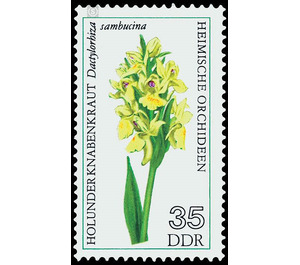Native orchids - Germany / German Democratic Republic 1976 - 35 Pfennig
Theme: Flora
| Country | Germany / German Democratic Republic |
| Issue Date | 1976 |
| Face Value | 35.00 |
| Color | green |
| Perforation | K 12 1/2: 13 |
| Printing Type | offset |
| Stamp Type | Postage stamp |
| Item Type | Stamp |
| Chronological Issue Number | 1880 |
| Chronological Chapter | GER-DDR |
| SID | 386078 |
| In 22 Wishlists | |
Native Orchids The Ministry of Posts and Telecommunications of the German Democratic Republic publishes six multi-colored special postal stamps depicting native orchids. NATURE RESPONSIBILITY - ORCHIDS With more than 20,000 species, orchids are one of the richest and most diverse plant families in the world. Since time immemorial, they claim the special interest of countless nature lovers because of their beauty and colourfulness. Their main area of distribution are the tropics and subtropics, where they mainly occur as tree-breakers (epiphytes). In temperate climates, including Europe, they are already reaching the limit of their distribution and are exclusively soil dwellers. Their share of the total number of European plant species reaches just under 2 percent. Here they are mainly bound to locations that were created by limited human intervention and management forms. This results in the particular problem of their conservation in Europe in connection with the worldwide efforts to protect them, in which the GDR, in which as one of the few countries without exception all orchids are protected, occupies a leading position in the world. 35-pfennig value: elderflower - Dactylorhiza sambucina (L.) SOO The species, scented for elderberry, reaching heights of 10 to 30 cm, is the oldest of the genus Dactylorhiza NEVSKI, which is today generally distinguished and still in its evolutionary stage. It inhabits North Africa, Europe and the Middle East. In Central Europe, this relatively large-flowered species, which is found predominantly yellow, rarely red-blooded, was formerly quite common on the poor meadows of the low mountain ranges and middle layers of the high mountains, which had been created and extensively managed by clearing; It occurred less often, mainly as Niederwaldpflanze, in the hills and plains. Today it is one of the most endangered rarities of Central European flora.


